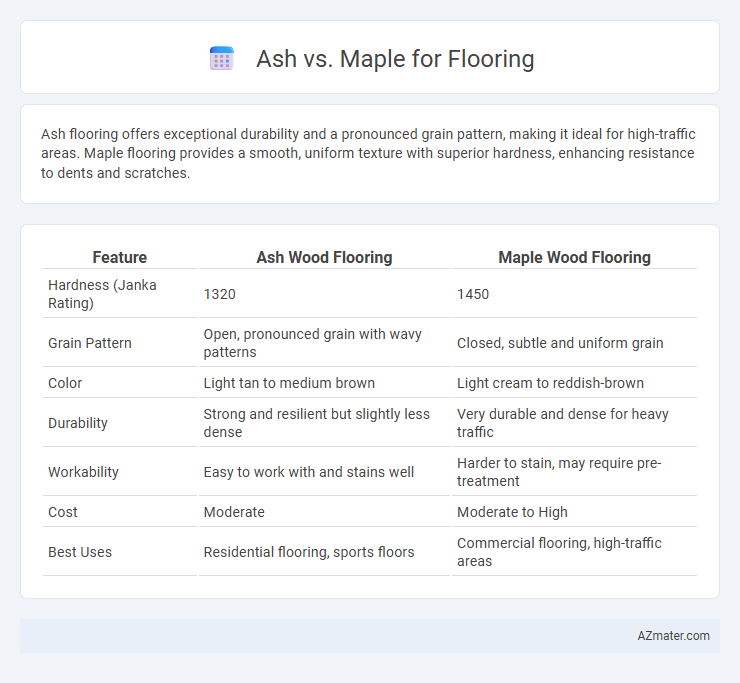Ash flooring offers exceptional durability and a pronounced grain pattern, making it ideal for high-traffic areas. Maple flooring provides a smooth, uniform texture with superior hardness, enhancing resistance to dents and scratches.
Table of Comparison
| Feature | Ash Wood Flooring | Maple Wood Flooring |
|---|---|---|
| Hardness (Janka Rating) | 1320 | 1450 |
| Grain Pattern | Open, pronounced grain with wavy patterns | Closed, subtle and uniform grain |
| Color | Light tan to medium brown | Light cream to reddish-brown |
| Durability | Strong and resilient but slightly less dense | Very durable and dense for heavy traffic |
| Workability | Easy to work with and stains well | Harder to stain, may require pre-treatment |
| Cost | Moderate | Moderate to High |
| Best Uses | Residential flooring, sports floors | Commercial flooring, high-traffic areas |
Ash vs Maple Flooring: An Overview
Ash and maple are both popular hardwood choices for flooring, with ash known for its pronounced grain patterns and lighter color variations, while maple offers a smooth, uniform texture and generally harder surface. Ash flooring provides greater elasticity and shock resistance, making it ideal for high-traffic areas, whereas maple's dense structure enhances durability and is resistant to dents. Both woods deliver excellent longevity and aesthetic appeal, but selection depends on desired appearance and specific usage requirements.
Appearance and Grain Patterns
Ash flooring showcases a light, creamy color with prominent, straight grain patterns that create a clean and uniform appearance, enhancing modern and rustic interiors. Maple flooring offers a smooth, fine texture with subtle grain lines and a pale, slightly golden hue, contributing to an elegant and timeless look. Both hardwoods provide durability, but ash's distinct grain makes it ideal for bold design statements, while maple's softer grain suits minimalist aesthetics.
Hardness and Durability
Ash flooring boasts a Janka hardness rating of approximately 1320, making it highly resistant to dents and suitable for high-traffic areas. Maple offers an even higher Janka hardness around 1450, providing superior durability and wear resistance for long-lasting floors. Both woods deliver robust performance, but maple's increased hardness lends greater protection against scratches and impacts over time.
Color Variations and Aging
Ash flooring offers a wide range of color variations, from creamy white to light brown hues, which tend to darken subtly over time, enhancing its natural warmth. Maple flooring features a consistent pale cream to light reddish-brown tone that generally lightens with age, maintaining a bright and clean appearance. Both hardwoods develop unique patinas through wear and exposure, but ash's pronounced grain and color contrast become more pronounced, while maple's smooth texture and uniform color provide a more subtle aging effect.
Cost Comparison
Ash flooring typically costs between $6 to $10 per square foot, offering a more budget-friendly option compared to maple, which ranges from $8 to $12 per square foot. The price difference is influenced by ash's faster growth rate and greater availability, making it more economical for large-scale projects. Despite the lower cost, ash provides comparable durability and aesthetic appeal, making it a cost-effective choice for homeowners seeking quality hardwood flooring.
Installation and Maintenance
Ash flooring offers a straightforward installation process due to its consistent grain and hardness, making it suitable for both nail-down and glue-down methods. Maple flooring, while harder and more durable, requires precision during installation to avoid damage, often favoring glue-down or floating techniques. In terms of maintenance, ash floors need regular sweeping and occasional refinishing to preserve their lighter tone, whereas maple floors resist dents well but benefit from routine cleaning and periodic sealing to maintain their smooth, dense surface.
Suitability for High-Traffic Areas
Ash flooring is highly suitable for high-traffic areas due to its exceptional hardness and durability, with a Janka hardness rating of around 1320, making it resistant to dents and wear. Maple, with a higher Janka hardness of approximately 1450, offers even greater resistance to abrasion and impact, ideal for spaces subjected to heavy foot traffic. Both hardwoods provide excellent performance and longevity, but maple's superior density makes it slightly more resilient for commercial or heavily used residential flooring applications.
Environmental Impact and Sustainability
Ash flooring is harvested from fast-growing trees, making it a more renewable choice with a lower carbon footprint compared to slower-growing hardwoods like maple. Maple, while durable and long-lasting, typically requires more time to mature, leading to increased environmental impact through extended deforestation periods. Choosing Ash supports sustainable forestry practices by promoting quicker forest regeneration and reducing habitat disruption.
Popular Design Styles
Ash flooring features a light, neutral tone with pronounced grain patterns that complement rustic, farmhouse, and Scandinavian interior designs. Maple offers a smooth, pale appearance with subtle grain, enhancing modern, minimalist, and contemporary styles due to its clean and sleek look. Both woods provide durability, but ash's bold texture contrasts sharply with maple's uniformity, catering to distinct aesthetic preferences in popular flooring designs.
Choosing the Best Wood Flooring for Your Home
Ash flooring offers exceptional durability and a light, natural grain that brightens living spaces, making it ideal for high-traffic areas. Maple provides a harder surface with a fine, uniform grain and a smooth finish, perfect for homes seeking a sleek, contemporary look. Prioritize factors such as hardness (Janka rating: Ash around 1320, Maple around 1450), color preferences, and maintenance requirements when choosing the best wood flooring for your home.

Infographic: Ash vs Maple for Flooring
 azmater.com
azmater.com